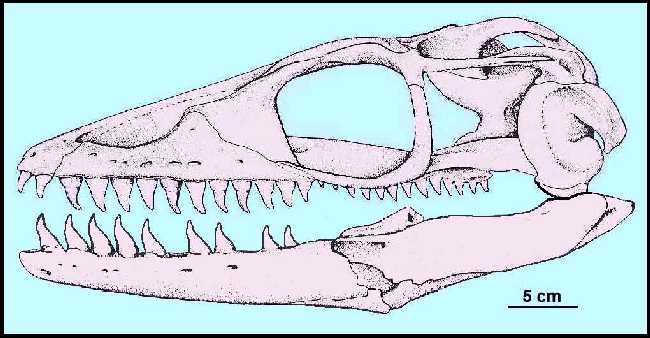 |
Plioplatecarpus:
A new mosasaur genus from Kansas
Copyright © 2001-2009 by Mike Everhart
Created 01/11/2001- Updated 01/30/2009
LEFT: Plioplatecarpus
skull adapted from drawings by Robert Holmes. Used with the permission of Robert
Holmes. Copyright © 2001 by Mike Everhart and Robert Holmes |
ABSTRACT: Everhart, M. J. and J. Bussen. 2001. First report of
the mosasaur, Plioplatecarpus cf. primaevus, from the Pierre Shale
(Campanian) of western Kansas. Kansas Academy of Science, Transactions
20(Abstracts): 28-29.
The fragmentary skull, vertebrae, and ribs of a
plioplatecarpine mosasaur were collected from the Pierre Shale in Logan County, KS, in
1995. Stratigraphically, the remains occurred about 6 m below a layer of large septarian
nodules in the upper Sharon Springs Member (early Campanian) in the zone of Baculites
maclearni [mclearni*]. Although most of the
skull was recovered, the bones are in poor condition due to the intrusion of selenite
crystals. The identity of the specimen was assumed to be Platecarpus at the time
of collection and the material remained in the possession of the property owner. A
re-assessment of the specimen in January 2001 identified the remains as Plioplatecarpus
cf. primaevus on the basis of the large parietal foremen which invades the suture
between the frontal and the parietal. Although Plioplatecarpus is well known from
the Pierre Shale in South Dakota and elsewhere in the Western Interior basin during the
early Campanian, this is the first documented occurrence of this genus in Kansas.
Examination of another private collection from the Sharon Springs Member in Logan County
revealed two additional possible examples of this genus which are much less complete. This
specimen provides additional information regarding the distribution of fauna in the
Western Interior Sea during Late Cretaceous time.
* Postscript: the proper spelling of the species
name, contrary to Cobban (1993), is mclearni; from B. mclearni Landes
1940
The genus Plioplatecarpus was created by Dollo in 1882 on the basis of
relatively incomplete European specimens (Plioplatecarpus marshi). The
first American material was probably that collected from the Navesink Formation of New
Jersey and published by Cope in 1869 as Mosasaurus depressus. Plioplatecarpus
primaevus was first collected in from the DeGrey Member (late Campanian) of the
Pierre Shale near Pierre, in Hughes County, South Dakota in 1958 by D. R. Crandell
(Russell, 1967). Holmes (1996) described the first relatively complete specimen of Plioplatecarpus
primaevus from the Upper Cretaceous Bearpaw Formation of south central
Saskatchewan in Canada. Burnham (1991) reported on a new species of Plioplatecarpus
from the Upper Demopolis Chalk Formation of Sumter County, Alabama.
Plioplatecarpus
is a comparatively late-comer as mosasaurs go, first appearing in the middle Campanian
(Martin, et al, 1996) and probably surviving until the end of the Cretaceous.
According to Russell (1967), Plioplatecarpus primaevus is very closely related to
the earlier genus, Platecarpus, which appears to have become extinct by the early
to middle Campanian (about 80 mya). Plioplatecarpus has been found in a
number of places around the world (Mississippi-Alabama, South Dakota, North Dakota, Canada,
Sweden, and the Netherlands). It is also the only mosasaur that has been found with
fetal material. This is an important indication that mosasaurs gave live birth to
their young.
The skull of Plioplatecarpus is relatively short compared to most
other mosasaurs and the eyes are proportionately larger. The number of teeth in the
jaws is reduced (12 or less) and the teeth are usually strongly recurved. There is a
reduced number of presacral vertebrae (29) and the scapula is larger than the coracoid.
The remains were found in the upper portion of the middle (organic-rich shale) unit of the
Sharon Springs Member in Logan County. This exposure is also considered to be early
Middle Campanian in age and contains both Baculites mclearni and B.
asperformis.
As an inhabitant of the Western Interior Sea, it should also have been found
the the Pierre Shale of western Kansas but had not been documented from that area until
now. The general poor quality of fossils from the Sharon Springs Member of the Pierre
Shale in Kansas due to selenite intrusion has generally discouraged serious collecting in
this part of Kansas. However, some very special fossils, including the type specimen
of Elasmosaurus platyurus Cope and other plesiosaurs,
the only specimen of Globidens from Kansas and the Plioplatecarpus
remains shown below suggest that this area is a rich resource of late Cretaceous marine
material. You can go to Ben Creisler's Mosasaur Pronunciation and
Translation Guide to learn more about the name Plioplatecarpus (and all the
other mosasaurs).
Based on the features of this skull and the other specimens of Plioplatecarpus
that have been found in the Western Interior Sea, it is most likely that these remains
will eventually be identified as Plioplatecarpus primaevus. It also appears
that this is probably one of the earliest reports of Plioplatecarpus from any
where.
Epilog: In February, 2005, I discovered that there may have been an earlier
specimen of Plioplatecarpus found as early as 1870 by B. F. Mudge. While it was
initially identified as "Liodon" by Cope and then placed in Platecarpus
(Cope, 1875), it was re-identified by Russell (1967) as Prognathodon. Other
workers (Lingham-Soliar, 1989) and Bell (1973) consider the remains to be that of Plioplatecarpus.
Read the full story here.
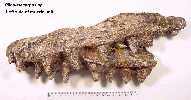 |
A view of the left side of the muzzle, showing the
premaxilla and the left maxilla, and including a medial view of the right maxilla.
(Scale is in mm) |
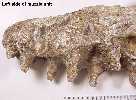 |
A close up of the anterior end of the left side of
the muzzle, showing the suture between the premaxilla and the left maxilla. |
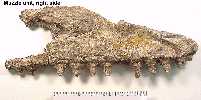 |
A view of the right side of the muzzle, showing the
suture between the premaxilla and the right maxilla. Both maxillae are complete and show a
total of eleven teeth in each. There are four teeth in the premaxilla. |
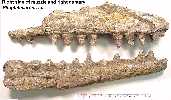 |
A view of the right side of the muzzle and lower jaw,
modified to remove the posterior portion of the left maxilla shown in the above picture. |
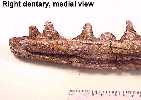 |
A medial view of the right dentary. There are
twelve teeth in the dentary. |
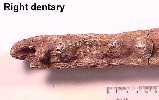 |
A view of the right dentary from above. |
 |
A view of the right dentary. |
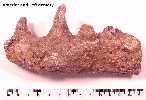 |
The anterior end of the left dentary. The bone
was deformed when it was preserved on top of a rib. |
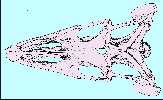 |
A dorsal view of the skull of Plioplatecarpus primaevus;
note the large parietal foramen and the invasion of the suture between the frontal and
parietal by the parietal foramen. (Adapted from the drawings
of Robert Holmes. Used with the permission of Robert Holmes. Copyright © 2001 by
Mike Everhart and Robert Holmes) |
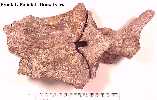 |
A dorsal view of the frontal and parietal. Note that the
parietal foramen is not as large as shown in the drawing above. This may be an
artifact caused by the invasion of selenite crystals into the bone. |
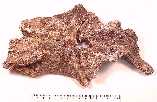 |
A ventral view of the frontal and anterior portion of the parietal |
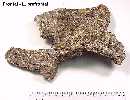 |
The left prefrontal and frontal showing the location of the large
opening for the left eye. |
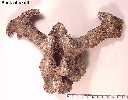 |
An anterior view of the braincase, including the basioccipital.
The two 'wing-like' structures are the exoccipitals They merge with the squamosal
and the parietal to form the suspensorium for the quadrate at the back of the head. The
brain of Plioplatecarpus was proportionally larger than that of most other
mosasaurs, following the trend found in some dinosaur lineages and in modern vs. primitive
birds. |
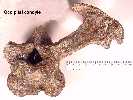 |
A posterior view of the braincase showing the occipital condyle
and the opening for the spinal cord. The braincase in mosasaurs is formed primarily from
the basioccipital on the bottom and the paired opisthotics on either side. The
'wings' that extend from the braincase (only one shown in this picture) are the
paroccipital processes of the opisthotic bones. They connect the braincase with the
squamosal and parietal bones at the back corners of the skull and provide the connection
for the quadrate bones (suspensorium). |
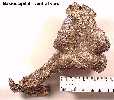 |
A ventral view of the basioccipital, including the right
opisthotic/paroccipital process. |
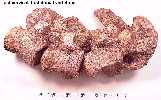 |
An articulated series of dorsal vertebrae, including
the last cervical vertebra (right). |
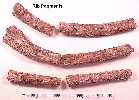 |
Several rib fragments found with the remains. Plioplatecarpus
ribs characteristically are round in shape, in contrast with the flattened appearance of
most mosasaur ribs. |
Additional reading:
Bardet, N., J. W. M. Jagt, M. M. M. Kuypers, and R. W. Dortangs. 1998. Shark
tooth marks on a vertebra of the mosasaur Plioplatecarpus marshi from the Late
Maastrichtian of Belgium. Publicaties van het Natuurhistorisch Genootschap in Limburg
41(1): 52-55.
Bell, G. L. Jr. 1997. A phylogenetic revision of North American and Adriatic
Mosasauroidea. pp. 293-332 In Callaway J. M. and E. L Nicholls, (eds.), Ancient
Marine Reptiles, Academic Press.
Burnham, D. A. 1991. A new mosasaur from the Upper Demopolis Formation of
Sumter County, Alabama, Masters Thesis, University of New Orleans, 63 pages.
Burnham, D. A. 1992. A new species of Plioplatecarpus (Squamata, Mosasauridae)
from the Sharon Springs Member of the Pierre Shale Formation (Campanian) of Wyoming. Jour.
Vert. Paleon. 12(suppl. to 3):20A.
Crandell, D. R. 1958. Geology of the Pierre area, South Dakota. U. S. Geol.
Surv. Prof. Paper 307, 83pp.
Everhart, M. J. and J. Bussen. 2001. First report of the
mosasaur, Plioplatecarpus cf. primaevus, from the Pierre Shale
(Campanian) of western Kansas. Kansas Acad. Sci. Trans. 20(Abstracts):28-29.
Holmes, R. B. 1996. Plioplatecarpus primaevus (Mosasauridae) from the
Bearpaw Formation (Campanian, Upper Cretaceous) of the North American Western Interior
Seaway, Jour. Vert. Paleon., 16(4):673-687.
Landes, R. W. 1940. Paleontology of the marine formations of the Montana Group,
Pt. 2, of Geology of the southern Alberta plains: Geological Survey of Canada, Memoir 221,
p. 129-217.
Lingham-Soliar, T. 1992. A new mode of locomotion in mosasaurs: Subaqueous
flying in Plioplatecarpus marshii, Jour. Vert. Paleon., 12(4):405-421.
Lingham-Soliar, T. 1994. The mosasaur Plioplatecarpus (Reptilia, Mosasauridae)
from Upper Cretaceous of Europe, Bulletin de L'Institut Royal des Sciences Naturelles de
Belgique, Sciences de la Terre, 64:177-221.
Martin, J. E., G. L. Bell, and J. L. Bertog. 1996. Distribution of
mosasaurs of the epicontinental seaway. GSA RM Sect. Ann. Meeting, Abstracts with
Programs, 28(4):16.
Russell, D. A. 1967. Systematics and morphology of American mosasaurs. Peabody
Museum of Natural History, Yale University, Bulletin 23.
Sheldon, M. A., G. L Bell, Jr., and J. P. Lamb. 1996. Histological
characters in prenatal specimens of the mosasaur, Plioplatecarpus primaevus.
Jour. of Vert. Paleon. 16(suppl. to 3):64A.

















